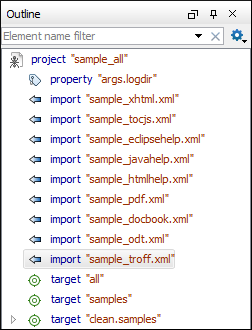Ant Outline View
The Outline view for Ant files displays the list of all the components (properties, targets, extension points, task/type definitions and references) from both the edited Ant build file and its imported and included modules. For Ant resources, the Outline view collects its components starting from the main files. The main files can be defined in the project and the main build file can be specified in a validation scenario. For more details, see Defining Main Files at Project Level.
By default, it is displayed on the left side of the editor. If the view is not displayed, it can be opened by selecting it from the menu.

 Settings menu on the Outline view toolbar:
Settings menu on the Outline view toolbar:- Filter returns exact matches
- The text filter of the Outline view returns only exact matches. By default, this filter is not selected.
 Selection
update on cursor move
Selection
update on cursor move- Controls the synchronization between Outline view and source document. The selection in the Outline view can be synchronized with the cursor moves or the changes in the Ant editor. Selecting one of the components from the outline view also selects the corresponding item in the source document.
When the  Show
components option is selected, the following actions are available:
Show
components option is selected, the following actions are available:
 Show XML structure
Show XML structure- Displays the XML document structure in a tree-like manner.
 Sort
Sort- Sorts the components in the Outline view alphabetically.
- Show all components
- Displays all components that were collected starting from the main file. This option is set by default.
- Show only local components
- Displays the components defined in the current file only.
- Group by location/type
- The build file components can be grouped by location and type.
 Show
XML structure option is selected, the following actions are available:
Show
XML structure option is selected, the following actions are available: Show
components
Show
components- Switches the Outline view to the components display mode.
 Flat presentation
mode of the filtered results
Flat presentation
mode of the filtered results- When active, the application flattens the filtered result elements to a single level.
 Show
comments and processing instructions
Show
comments and processing instructions- Show/hide comments and processing instructions in the Outline view.
 Show
element name
Show
element name- Show/hide element name.
 Show
text
Show
text- Show/hide additional text content for the displayed elements.
 Show
attributes
Show
attributes- Show/hide attribute values for the displayed elements. The displayed attribute values can be changed from the Outline preferences panel.
 Configure displayed
attributes
Configure displayed
attributes- Displays the XML Structured Outline preferences page.
The following actions are available in the contextual menu of the
Outline view (when the  Show XML structure
option is selected in the
Show XML structure
option is selected in the  Settings menu:
Settings menu:
- Append Child
- Displays a list of elements that can be inserted as children of the current element.
- Insert Before
- Displays a list of elements that can be inserted as siblings of the current element, before the current element.
- Insert After
- Displays a list of elements that can be inserted as siblings of the current element, after the current element.
 Edit Attributes
Edit Attributes- Displays an in-place attribute editing window.
 Toggle
Comment
Toggle
Comment- Comments/uncomments the currently selected element.
 Search References Ctrl + Shift
+ R (Command + Shift + R on macOS)
Search References Ctrl + Shift
+ R (Command + Shift + R on macOS)- Searches all references of the item found at current cursor position in the defined scope. See Find References and Declarations of Ant Components for more details.
- Search References in
- Searches all references of the item found at current cursor position in the specified scope. See Find References and Declarations of Ant Components for more details.
 Component Dependencies
Component Dependencies- Opens the Ant Component Dependencies view that allows you to see the dependencies for the currently selected component.
 Rename
Component in
Rename
Component in- Renames the selected component. See Ant Refactoring Actions for more details.
 Cut,
Cut,
 Copy,
Copy,
 Delete
Delete- Executes the typical editing actions on the currently selected component.
 Expand More
Expand More- Expands recursively all sub-components of the selected component.
 Collapse
All
Collapse
All- Collapses recursively all sub-components of the selected component.
You can search a component in the Outline view by typing its name in the filter text field at the top of the view or directly on the tree structure. When you type the component name in the text field, you can switch to the tree structure using the following:
- Down arrow key
- Tab key
- Shift-Tab key combination
To switch from tree structure to the filter text field, you can use Tab and Shift-Tab.
- * - any string
- ? - any character
- , - patterns separator
The content of the Outline view and the editing area are synchronized. When you select a component in the Outline view, its definition is highlighted in the editing area.
- For location, the names of the files are sorted alphabetically. The file you are editing is located at the top of the list.
- For type, the order is: properties, targets, references. Note: When no grouping is available Oxygen XML Editor sorts the components depending on their order in the document. Oxygen XML Editor also takes into account the name of the file that the components are part of.
